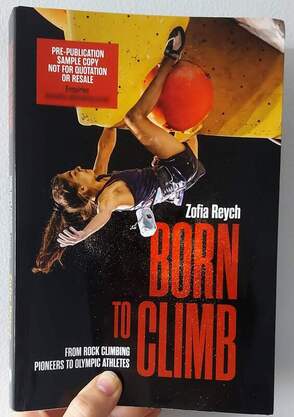
In Born to Climb, Zofia Reych traces the history of climbing from the 1300s right up to today. It’s a comprehensive look at how abilities, techniques and safety have progressed and how much climbing standards have improved, both on rock and in competitions. There are many historical accounts of climbing already out there (although I’m not aware of another one that covers ground right up to, and including, the 2020 Olympics), but what sets Zofia’s apart is its clear intention to be inclusive and representative. With this perspective, they manage to put a fresh spin on historical accounts that have already been covered so many times, and it’s refreshing to see a frank discussion of those who haven’t always been remembered or represented in more traditional climbing accounts.
Born to Climb has a huge scope, with an incredible amount of research gone into it and if anything possibly tries to cover too much ground. I did find the opening chapters a touch on the slow side, but it picked up pace quickly. I really enjoyed reading an account of climbing history that wasn’t Brit-centric, and although I was already familiar with most of the climbs detailed here, there’s so much discussed that there was still plenty of new information. There’s a brief mention of mountaineering’s historical involvement in the Olympics, but otherwise the narrative is strictly focused on climbing (both indoor and outdoor) – probably a good limitation as there is already so much information to include.
What feels incredibly valuable is Zofia’s commitment to highlighting the effect climbing has had on nearby groups who don’t normally get mentioned in the conversation. I had no idea, for example, about the existence of the Ahwahneechee people living in the Yosemite valley, or of the shocking disruption forced on them by the authorities as tourism to Yosemite increased. Zofia balances the history of climbing alongside a few of their own experiences. They explains that the aim of this is to contextualise the accomplishments detailed in the historical narrative – in truth, I’m not sure how much someone who doesn’t climb would really be able to grasp the different between, say, a 6b and a 9a. But I found the chapters relating their experiences relatable and compelling; Zofia relays these stories with honesty and wit, and I would have happily read more of these chapters. I’m looking forward to seeing what they write next. (With thanks to the lovely folk at Vertebrate Publishing for a free copy in exchange for an honest review.)
0 Comments
Leave a Reply. |
book REVIEWSPredominantly climbing/outdoors literature, mountaineering history and nature writing. Archives
July 2023
Categories
All
|
 RSS Feed
RSS Feed


